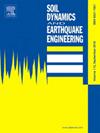基于时频非稳态地动模型和随机脉冲模型的时频非稳态随机近断层撺阶地动合成
IF 4.6
2区 工程技术
Q1 ENGINEERING, GEOLOGICAL
引用次数: 0
摘要
众所周知,近断层跃层地面运动(NFFS-GMs)会造成巨大的永久地面位移,与远场地面运动相比,会对长周期柔性结构造成更大的结构破坏。此外,即使在同一地震事件中,脉冲参数(如永久地表位移 Dsite 和脉冲周期 Tp)也会有很大不同。尽管随机 NFFS-GM 非常重要,但对其的研究仍然有限。针对这一空白,本文提出了一种针对特定地震场景的时频非稳态随机近断层跃层地面运动的合成方法。首先,我们采用离散小波变换(DWT)方法,利用五个母小波函数(MWF)对 210 个 Chi-Chi 地面运动进行分析。该分析确定了 41 个有效的 NFFS-GM。通过比较原始地面运动的位移时间历程,验证了识别方法的有效性。随后,利用亚伯拉罕森提出的平步(FS)脉冲模型,结合非线性最小二乘法,得出了脉冲参数。然后,通过皮尔逊相关分析和非线性最小二乘法,建立脉冲参数与断层距离 R 的地震学参数相关的回归模型。回归模型的残差 σlnDsite 和 Tp 被视为随机变量,并确定其概率分布。之后,引入一个新的随机脉冲模型来模拟低频地面运动,同时使用一个时频非稳态模型来模拟高频地面运动。通过反傅里叶变换,在频域合成这些分量,从而得到时频非稳态随机近断层跃层地面运动(TFNS-SNFFS-GM)。最后,通过比较合成地面运动与实际 NFFS-GM 的响应谱,证实了所提方法的有效性。本文章由计算机程序翻译,如有差异,请以英文原文为准。
Synthesis of the time-frequency non-stationary stochastic near-fault fling-step ground motion based on time-frequency non-stationary ground motion model and stochastic pulse model
Near-fault fling-step ground motions (NFFS-GMs) are known to cause significant permanent ground displacements, resulting in greater structural damage for long-period flexible structures compared to far-field ground motions. Furthermore, even during the same seismic event, the pulse parameters—such as permanent ground displacements and pulse period —can vary considerably. Despite their importance, research on stochastic NFFS-GMs remains limited. To address this gap, this paper proposes a method for synthesizing the time-frequency non-stationary stochastic near-fault fling-step ground motion for a specific seismic scenario. Firstly, we employ the discrete wavelet transform (DWT) method, utilizing five mother wavelet functions (MWFs) to analyze 210 Chi-Chi ground motions. This analysis identifies 41 valid NFFS-GMs. The effectiveness of the identification method is validated by comparing the displacement time histories of the original ground motion. Pulse parameters are subsequently derived using the fling-step (FS) pulse model proposed by Abrahamson, in conjunction with the nonlinear least-squares method. A regression model correlating pulse parameters with the seismological parameter of the fault distance R is then developed through Pearson correlation analysis and the nonlinear least-squares method. The residuals of the regression model and are treated as random variables, and their probability distributions are determined. After that, a new stochastic pulse model is introduced to simulate low-frequency ground motions, while a time-frequency non-stationary model is used to simulate high-frequency ground motions. These components are synthesized in the frequency domain to obtain the time-frequency non-stationary stochastic near-fault fling-step ground motion (TFNS-SNFFS-GM) via inverse Fourier transform. Finally, the effectiveness of the proposed method is confirmed by comparing the response spectrum of the synthesized ground motion with that of actual NFFS-GMs.
求助全文
通过发布文献求助,成功后即可免费获取论文全文。
去求助
来源期刊

Soil Dynamics and Earthquake Engineering
工程技术-地球科学综合
CiteScore
7.50
自引率
15.00%
发文量
446
审稿时长
8 months
期刊介绍:
The journal aims to encourage and enhance the role of mechanics and other disciplines as they relate to earthquake engineering by providing opportunities for the publication of the work of applied mathematicians, engineers and other applied scientists involved in solving problems closely related to the field of earthquake engineering and geotechnical earthquake engineering.
Emphasis is placed on new concepts and techniques, but case histories will also be published if they enhance the presentation and understanding of new technical concepts.
 求助内容:
求助内容: 应助结果提醒方式:
应助结果提醒方式:


